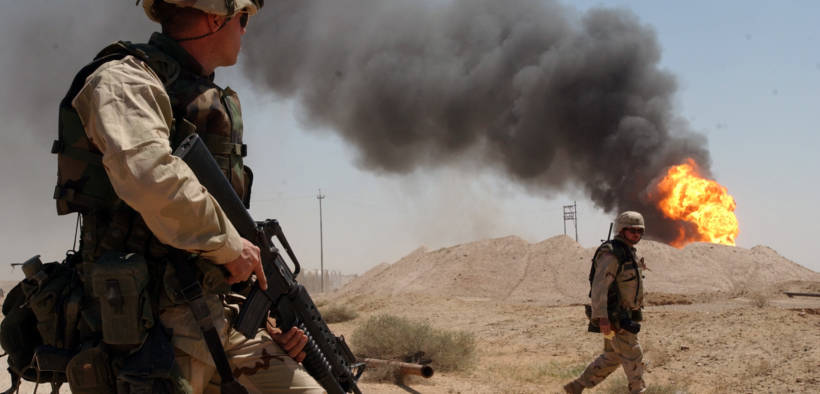Hasn’t the US Been a Greater Source of Instability in the Middle East Than Iran?

Think for a moment how different Iran and the Middle East’s fate would have been if the CIA, along with the British, did not orchestrate a military coup to overthrow the democratically-elected government of Iran.
(By Nasim Ahmed, MEMO) During a televised discussion over which country has been the main source of instability in the Middle East, I struggled to place Iran ahead of the US. While it is self-evident that no single country can be held responsible for all of the region’s pain and suffering – just as every individual possesses some degree of agency, however small that may be, so do states and governments – it would be dishonest to look beyond the US in such conversations.
American posture towards the Middle East is best summed up by the well-known proverb, “if a hammer is all you have, everything looks like a nail”. The proverb often used to highlight the limits and dangers of unrivaled military power has become particularly relevant to the US because of its many failed and needless military misadventures. Unprecedented supremacy of the last standing superpower and its monster-sized arms industry, dependent on a steady supply of war to justify its very existence, has turned the military option from the last resort to the most tempting solution to any foreign policy crises.
From Latin America – where the US destabilized the region by violently ousting democratically elected governments through the use of proxies and armed militias – to the Middle East – where it provided a security umbrella for the region’s dictators, tyrants and illegal occupiers – the instinct of American presidents has been to shoot first and deal with repercussions after.
The assassination of Iraqi General Qassim Soleimani is a case in point. Following the drone strike, the Trump administration has been struggling to draft an after-the-fact narrative to justify the killing. No credible evidence has been presented to suggest he was an “imminent threat”, as White House officials claimed. The Pentagon has also contradicted the US president’s claim that Soleimani was planning to target four US embassies in the region. Trump finally resigned to the fact that piecing together a believable narrative was impossible and admitted as much in a tweet saying “it doesn’t really matter, because of his horrible past.”
The Fake News Media and their Democrat Partners are working hard to determine whether or not the future attack by terrorist Soleimani was “imminent” or not, & was my team in agreement. The answer to both is a strong YES., but it doesn’t really matter because of his horrible past!
— Donald J. Trump (@realDonaldTrump) January 13, 2020
Soleimani’s killing triggered a chain of events that led to a strike on a Ukrainian passenger plane killing all 176 aboard. In the wake of this tragedy, Canadian Prime Minister Justin Trudeau blamed Washington for their death having previously sidestepped questions over whether the American president bears any responsibility for the disaster.
This recent escalation is just one of dozens that could be cited to make the case against America. While the 2003 illegal invasion of Iraq is the most obvious starting point for highlighting the main source of instability in the region, there are reasons to suggest that a much earlier American intervention set the region on its current course.
Think for a moment how different Iran and the region’s fate would have been if the CIA, along with the British, did not orchestrate a military coup to overthrow the democratically-elected government of Prime Minister Mohammad Mosaddegh to install the tyranny of Mohammad Reza Pahlavi in 1953. America’s gift to the Iranian people was more than two decades of oppression under the Shah who in turn was overthrown by a popular uprising that ushered in the reign of Shia Mullahs led by Ayatollah Khomeini.
The 1979 Revolution triggered a hostile global response that hardened the destructive paranoia of the Mullahs. Faced against the might of the greatest superpower in history, increased militarization and a nuclear program that could potentially pave the way for Iran to become the second country in the region after Israel to get it hands on nuclear weapons, would have presented themselves as the only means of defense against another western led regime change.
This belief was further reinforced seven months later when the same world powers gave their support to Saddam Hussain during his eight-year war with Iran. Over a million people lost their lives fighting the Iraqi dictator armed by the US with chemical weapons. Two years after the war, where neither side achieved anything resembling victory and suffered terrible loss, the Iraqi dictator turned on his US and Gulf allies as another war ensued.
While the 1991 Gulf War ended with Iraq’s withdrawal from Kuwait, it nonetheless strengthened Hussain’s grip on power, not least because then US President George H W Bush betrayed the Iraqi people by failing to support a popular uprising against Hussain having encouraged them to rise up against the dictator. As many as 100,000 Iraqi’s lost their lives, planting mistrust of the US firmly in Arab minds if it wasn’t so already.
The region fell hostage to the succession of war and betrayal along with the imminent threat of bottom up revolution or US led regime change. While Iran, fearing yet another regime change, had its own security issues to contend with, governments in Middle Eastern capitals dreaded the prospect of being consumed by what they saw as a revolutionary zeal ushered in by the 1979 Revolution. This was certainly one of the reasons for Saddam Hussain’s decision to go to war with Iran.
In Saudi Arabia the ripple effect was immediate. Zealots laid siege to the sacred mosque in Makkah, hoping no doubt to light the fuse for an Iran style takeover. Royals in Riyadh became spooked and feared a similar fate as that of the Shah. Fortunately for them, they were able to channel the revolutionary zeal in other ways. Granting greater power and resource to the religious bodies to proselytize Saudi Wahhabism around the Islamic world was one way of channeling the religious fervor within the country. Another was to facilitate the arming and execution of war in Afghanistan against Russia. This conflict arrived at a fortunate moment for the kingdom. Militants that may have deemed the kingdom and its unelected leaders as illegitimate rulers found in the ungodly communist an unalloyed enemy. As the Saudis later discovered though, the war with the USSR only delayed the inevitable reckoning with the likes of Al-Qaeda leader Osama Bin Laden.
Nearly four decades later Saudi Crown Prince Mohamed Bin Salman offered a telling account of the kingdom’s cold war with Iran. The Iranian Revolution, he explained, was a seismic event, whose effect rippled through the region. Bin Salman, who appears to harbor even greater hostility for the Iranians than previous Saudi leaders, suggested that his predecessors were locked with Tehran in a challenge between two types of fanaticism to determine who could demonstrate the most religious zeal.
While the notion that Saudi Arabia had not embraced religious extremism prior to the Iranian Revolution is obviously flawed and only serves the crown prince’s goal of demonizing Iran, it is nevertheless true to suggest that the two countries were locked in a bitter feud. The Saudi monarchy, enriched with oil, empowered its Sunni clerics in spreading Wahhabism around the Islamic world to ensure that its status as the leader of the Muslim world, symbolically at least, was not endangered by Iran.
A number of damaging ideas about the region and the governance of the people congealed during this period. Many were just borrowed racist orientalist notions that Arabs are incapable of governance let alone democracy and required an external power to maintain stability otherwise the region would be consumed by hate and war. Suggesting that the external power may in fact be the source of instability was tantamount to heresy.
Different shades of authoritarian governments imbibed this belief and feared their own population. In the regional cold war, governments of all shapes and sizes not only became suspicious of each other, they became even more suspicious of their own citizens. This sowed distrust to cruel and devastating effect. Locked into this cycle of fanaticism, state repression and militarization, were being cultivated as the primary means of state survival while radical thinking and revolutionary zeal remained the only path for exercising political agency.
After another round of US escalation, isn’t it time to conclude that America has been the main source of instability in the region?
















Headline sounded good but u immediately sabotaged ALL your credibility with a blatant, stupid lie. Iran was a monarchy under the shah prior to revolution led by Khomenei, uhhhhhh.